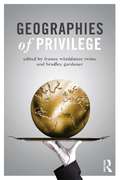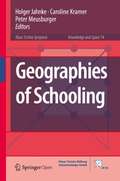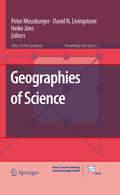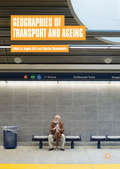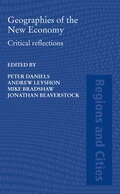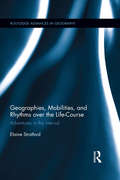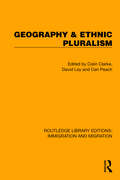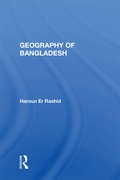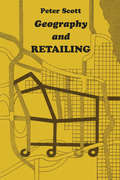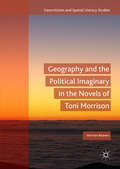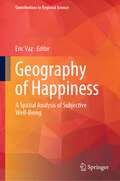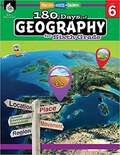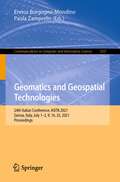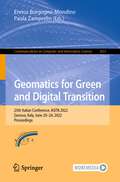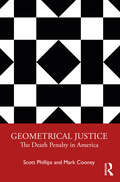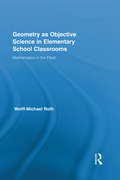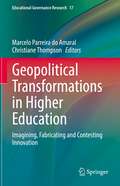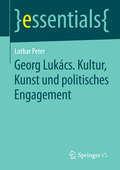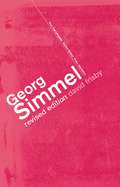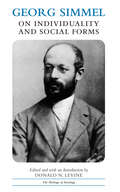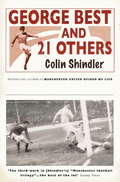- Table View
- List View
Geographies of Privilege
by France Winddance Twine Bradley GardenerHow are social inequalities experienced, reproduced and challenged in local, global and transnational spaces? What role does the control of space play in distribution of crucial resources and forms of capital (housing, education, pleasure, leisure, social relationships)? The case studies in Geographies of Privilege demonstrate how power operates and is activated within local, national, and global networks. Twine and Gardener have put together a collection that analyzes how the centrality of spaces (domestic, institutional, leisure, educational) are central to the production, maintenance and transformation of inequalities. The collected readings show how power--in the form of economic, social, symbolic, and cultural capital--is employed and experienced. The volume’s contributors take the reader to diverse sites, including brothels, blues clubs, dance clubs, elite schools, detention centers, advocacy organizations, and public sidewalks in Canada, Italy, Spain, United Arab Emirates, Mozambique, South Africa, and the United States. Geographies of Privilege is the perfect teaching tool for courses on social problems, race, class and gender in Geography, Sociology and Anthropology.
Geographies of Schooling (Knowledge and Space #14)
by Peter Meusburger Holger Jahnke Caroline KramerThis open access book explores the complex relationship between schooling as a set of practices embedded in educational institutions and their specific spatial dimensions from different disciplinary perspectives. It presents innovative empirical and conceptual research by international scholars from the fields of social geography, pedagogy, educational and social sciences in Germany, the United Kingdom, France, Czechia, Hungary, Austria, Switzerland, Norway and Canada. The book covers a broad range of topics, all examined from a spatial perspective: the governance of schooling, the transition processes of and within national school systems, the question of small schools in peripheral areas as well as the embeddedness of schooling in broader processes of social change. Transcending disciplinary boundaries, the book offers deep insights into current theoretical debates and empirical case studies within the broad research field encompassing the complex relationship between education and space.
Geographies of Science
by David Livingstone Peter Meusburger Heike JönsThis collection of essays aims to further the understanding of historical and contemporary geographies of science. It offers a fresh perspective on comparative approaches to scientific knowledge and practice as pursued by geographers, sociologists, anthropologists, and historians of science. The authors explore the formation and changing geographies of scientific centers from the sixteenth to the twentieth centuries and critically discuss the designing of knowledge spaces in early museums, in modern laboratories, at world fairs, and in the periphery of contemporary science. They also analyze the interactions between science and the public in Victorian Britain, interwar Germany, and recent environmental policy debates. The book provides a genuine geographical perspective on the production and dissemination of knowledge and will thus be an important point of reference for those interested in the spatial relations of science and associated fields. The Klaus Tschira Foundation supports diverse symposia, the essence of which is published in this Springer series (www.kts.villa-bosch.de).
Geographies of Transport and Ageing
by Charles Musselwhite Angela CurlThis book presents a unique geographical perspective on issues of transport and mobility for ageing populations. Society is ageing across the globe. As well as living longer, older people are fitter, healthier and more active than previous generations were. There is both a desire and a need to be mobile in later life and mobility is clearly linked to older people’s health and wellbeing. Yet mobility can be hard for older people and we don’t always design our neighbourhoods, towns, cities and villages in an age friendly way.With case studies from across the globe, authors take a geographical lens to the important topic of transport and mobility in later life. Chapters examine how the relationships between mobility, modes of transport, place and technologies affect an aging population.This collection will be of interest to scholars and students in human geography, in particular those with interests in transport geography, mobilities, geographies of health and wellbeing, urban geographies and geographical gerontology. It will also appeal to practitioners and policy makers in urban design and planning, transport planning and engineering and public health who have interests in age-friendly cities and policy.
Geographies of the New Economy: Critical Reflections (Regions and Cities)
by Andrew Leyshon Jonathan Beaverstock Peter W. Daniels Michael J. BradshawWhat is the 'new economy'? Where is it? How does it differ from the 'old economy'? How does the 'new economy' relate to issues such as the nature of work, social inclusion and exclusion? Geographies of the New Economy explores the meaning of the 'new economy' at the global scale from the perspective of advanced post-socialist and emerging economies. Drawing on evidence from regions around the world, the book debates the efficacy of the widely used concept of the ‘new economy’ and examines its socio-spatial consequences. This book is important reading for policy-makers, academics and students of geography, sociology, urban studies, economics, planning and policy studies.
Geographies, Mobilities, and Rhythms over the Life-Course: Adventures in the Interval (Routledge Advances in Geography)
by Elaine StratfordBy thinking in terms of the geographies of mobilities, we are better able to understand the central importance of movements, rhythms and shifting emplacements over the life-course. This innovative book represents research from a new and flourishing multidisciplinary field that includes, among other things, studies on smart cities, infrastructures and networks; mobile technologies for automated highways or locative media; mobility justice and rights to stay or enter or reside. These activities, cadences and changing attachments to place have profound effects—first upon how we conduct or govern ourselves and each other via many social institutions, and second upon how we constitute the spaces in and through which our lives are experienced. This scholarship also has clear connections to numerous aspects of social and spatial policy and planning.
Geography & Ethnic Pluralism (Routledge Library Editions: Immigration and Migration #9)
by Colin ClarkeGeography & Ethnic Pluralism (1984) examines the debate around pluralism – the segmentation of population by race and culture – as a social and state issue, and explores this issue in Third World and metropolitan contexts. The field is opened up by a re-examination of the seminal work of J.S. Furnivall and M.G. Smith and by exploring the significance of racial and cultural diversity in colonial, post-colonial and metropolitan situations. Case studies written by specialists are presented in each chapter; they represent a wide range of locales, indicating the global nature of the theme and emphasising the variable significance of ethnicity in different situations.
Geography Alive! Regions and People, Student Edition
by Teachers' Curriculum InstituteNIMAC-sourced textbook
Geography Of Bangladesh
by Haroun Er RashidIn its struggle for independence, Bangladesh became the focal point of world attention in the early 1970s. It emerged victorious, but its development was hindered by the after-effects of the war—the destruction of much of its infrastructure, problems of governmental change, and the enormous difficulties faced by government and aid officials in assembling a data base for long-range planning. Professor Rashid's book—the first major comprehensive geographic inventory of Bangladesh—provides the key elements for such a base. Emphasizing the rural and agricultural characteristics of the country, it also covers in depth its physiography, hydrography, climate, soils, land utilization, migration and settlement patterns, transportation infrastructure, and human and natural resources.
Geography and Retailing
by Peter ScottAn important contribution to our understanding of the distribution of retail activities, particularly within cities, this book provides a critical review of the literature on the subject. It points out the major general propositions concerning retailing from the geographical point of view, and identifies key research problems, which need to be examined in order to push forward the frontiers of this sub field of economic geography. It presents a major critique of the central-place model, which has come to hold an important place in the methodology of economic geography, and clearly and decisively shows the model to be static, deterministic, retrospective and of little value for predictive purposes.
Geography and the Political Imaginary in the Novels of Toni Morrison (Geocriticism and Spatial Literary Studies)
by Herman BeaversThis book examines Toni Morrison’s fiction as a sustained effort to challenge the dominant narratives produced in the white supremacist political imaginary and conceptualize a more inclusive political imaginary in which black bodies are valued. Herman Beavers closely examines politics of scale and contentious politics in order to discern Morrison's larger intent of revealing the deep structure of power relations in black communities that will enable them to fashion counterhegemonic projects. The volume explores how Morrison stages her ruminations on the political imaginary in neighborhoods or small towns; rooms, houses or streets. Beavers argues that these spatial and domestic geographies are sites where the management of traumatic injury is integral to establishing a sense of place, proposing these “tight spaces” as sites where narratives are produced and contested; sites of inscription and erasure, utterance and silence.
Geography of Happiness: A Spatial Analysis of Subjective Well-Being (Contributions to Regional Science)
by Eric VazThis book offers readers a spatial understanding of happiness and subjective well-being. By integrating spatial and geostatistical methods, it sheds new light on the spatial and geographical aspects of subjective well-being. Geographical analysis allows us to measure spatial and regional discrepancies in subjective well-being and to identify heterogeneous profiles in terms of social, economic and environmental patterns. Consequently, the papers gathered here address various topics concerning the spatial aspects of subjective well-being, including social injustice, age, new urban spaces, and tourism. The book proposes a multidisciplinary approach and is intended for scholars and students in the fields of geography, economics and the spatial sciences. By examining several critical dimensions of happiness and subjective well-being, it enriches the complexity of regional decision-making on the path toward happier and more liveable societies.
Geography, Level 6: Practice, Assess, Diagnose
by Jennifer EdgertonSupplement your social studies curriculum with 180 days of daily geography practice! This essential classroom resource provides teachers with weekly geography units that build students' geography knowledge, and are easy to incorporate into the classroom. <p><p> In a world that is becoming more connected and globalized, 21st century students must have the skills necessary to understand their world and how geography affects them and others. Students will develop their map and spatial skills, learn how to answer text- and photo-dependent questions, and study the 5 themes of geography. Each week covers a particular topic and introduces students to a new place or type of map. <p><p> The first two weeks consist of a mini-unit that focuses entirely on map skills. For additional units, students will study various places, and how culture and geography are related. With a focus on the six populated continents, students will explore various types of maps including physical maps, political maps, topographic maps, thematic maps, climate maps, regional maps, and various topics including scale, legends, cardinal directions, latitude and longitude, and more. Aligned to state standards and National Geography Standards, this resource includes digital materials.
Geomatics and Geospatial Technologies: 24th Italian Conference, ASITA 2021, Genoa, Italy, July 1-2, 9, 16, 23, 2021, Proceedings (Communications in Computer and Information Science #1507)
by Enrico Borgogno-Mondino Paola ZamperlinThis volume constitutes selected papers presented at the 24th Italian Conference on Geomatics and Geospatial Technologies, ASITA 2021, held as five sessions takind place between 1 and 23 July, 2021. Due to the COVID-19 pandemic the conference was held online.The 28 papers were thoroughly reviewed and selected from 139 submissions. They are organized in topical sections on remote sensing applications; geomatics and natural hazards; geomatics for cultural heritage and natural resources; sensors performance and data processing; geomatics and land management.
Geomatics for Green and Digital Transition: 25th Italian Conference, ASITA 2022, Genova, Italy, June 20–24, 2022, Proceedings (Communications in Computer and Information Science #1651)
by Enrico Borgogno-Mondino Paola ZamperlinThis book constitutes the proceedings of the 25th Italian Conference on Geomatics for Green and Digital Transition, ASITA 2022, held in Genova, Italy, in June 2022.The 33 full papers included in this book were carefully reviewed and selected from 60 submissions. They were organized in topical sections as follows: Positioning, Navigation and Operational Geodesy; Data exploitation: services and tools; Geo(big)data, GeoAnalytics, AI and Decision Support; Agriculture and Forestry; Cultural Heritage and Landscape Analysis; Environmental Monitoring and Analysis; and Sustainable Development and Climate Change.
Geometrical Justice: The Death Penalty in America
by Scott Phillips Mark CooneyLegal decisions continue to mystify: why was this person sentenced to 20 years in prison, but that person to just 10 years for the same crime? Why did one person sue for civil damages, but another let the matter drop? Legal rules are supposed to answer these questions, but their answers are radically incomplete. Wouldn’t it be wonderful to have a theory that predicted and explained legal decisions? Drawing on Donald Black’s theoretical ideas, Geometrical Justice: The Death Penalty in America addresses these issues, focusing specifi cally on who is sentenced to death and executed in the United States. The book explains why some murders are more serious than others and how the social characteristics of defendants, victims, and jurors aff ect case outcomes. Building on the most rigorous data in the field, the authors reveal wide discrepancies in capital punishment – why one person lives, but another person dies. Geometrical Justice will be of interest to those engaged in criminal justice, criminology, and socio- legal studies, as well as students taking courses on sentencing, corrections, and capital punishment.
Geometry as Objective Science in Elementary School Classrooms: Mathematics in the Flesh (Routledge International Studies in the Philosophy of Education)
by Wolff-Michael RothThis study examines the origins of geometry in and out of the intuitively given everyday lifeworlds of children in a second-grade mathematics class. These lifeworlds, though pre-geometric, are not without model objects that denote and come to anchor geometric idealities that they will understand at later points in their lives. Roth's analyses explain how geometry, an objective science, arises anew from the pre-scientific but nevertheless methodic actions of children in a structured world always already shot through with significations. He presents a way of understanding knowing and learning in mathematics that differs from other current approaches, using case studies to demonstrate contradictions and incongruences of other theories – Immanuel Kant, Jean Piaget, and more recent forms of (radical, social) constructivism, embodiment theories, and enactivism – and to show how material phenomenology fused with phenomenological sociology provides answers to the problems that these other paradigms do not answer.
Geophysical Methods for Cultural Heritage Management (Springer Geophysics)
by Salvatore Piro Marilena Cozzolino Elisa Di Giovanni Paolo Mauriello Daniela ZamunerThis book provides information and tools necessary to bridge and integrate the knowledge gaps related to the acquisition and processing of archaeological data, specifically in the field of preventive diagnostics, urban centers, archaeological parks and historical monuments, through activities that involve the application of non-invasive diagnostic detection systems, in the field of applied geophysics. The principal aim of this book is to define a tool for experts that work in the frame of Cultural Heritage and to identify a procedure of intervention transferable and usable in different geographical contexts and areas of investigations: it could help to decide the better technique of investigation to apply in relation to the predictive characteristics of the archaeological site and the objectives of the survey. The book is divided in two parts. The first one explains the theory of ground high resolution penetrating radar (GPR), electrical resistivity tomography (ERT), controlled source electromagnetism system, differential magnetic method and the scenario of integrated methods of different geophysical techniques. Each section covers the basic theory (complete description of the physical parameters involved in the method), field instruments (description of all systems actually offered by commercial companies), field techniques (presentation of the main procedures and setting parameters used to explore the ground surface during data acquisition), techniques of data processing and representation (main processing routines and comparison between different techniques; presentation of different typologies of graphical representation), and the possibility and limitations of methods (explanation of best and worst conditions of implementation of the geophysical technique in relation to the contrasts between archaeological features and the natural background and the features of the instruments and arrays). The second part describes some applications of geophysical prospection to Cultural Heritage in detailed case histories, divided in sections relative to monuments, historical buildings, urban centres, archaeological parks and ancient viability. Moreover, examples of integration of three-dimensional reliefs and geophysical diagnostic of a monuments and studies of large scale reconnaissance implemented into a Geographical Information System are treated. In each case study the authors cover the description of the archaeological or historical contest; an explanation of the problem to solve; a choice of the geophysical methods; the setting of the procedure of data acquisition; techniques of data processing; a representation, interpretation, and discussion of the results.
Geopolitical Transformations in Higher Education: Imagining, Fabricating and Contesting Innovation (Educational Governance Research #17)
by Christiane Thompson Marcelo Parreira do AmaralThis book discusses the central role education and research play in generating both value and comparative advantages in the (imageries of) global competition, competitiveness and transnational value chains. They are seen as assets placed at the forefront of developments that are arguably reshaping individuals, society and economy. This edited volume explores these developments in terms of changing relations between society, economy, science and individuals. The idea that we live in global knowledge societies and knowledge-based economies or that present-day productive systems constitute an industry 4.0 have gained currency as descriptions of contemporary society that are said to bear direct and indirect consequences for political, economic, and social orders. In this context, innovation, science and education are central themes in contemporary discussions about the future of modern societies. Innovation is enthusiastically embraced as the panacea for all sorts of societal issues of our times; science is equally deemed to play a decisive role in solving current problems and in heralding a bright future with more wealth and more welfare for all citizens; education is conferred the task to producing individuals equipped with both skills and competences considered key to innovation but also displaying the attitudes and dispositions that will secure continuous innovation and economic growth.
Georg Lukács. Kultur, Kunst und politisches Engagement (essentials)
by Lothar PeterDer Verfasser gibt einen Überblick über Leben und Werk von Georg Lukács, einem bedeutenden Philosophen und Kulturtheoretiker des 20. Jahrhunderts. Im Mittelpunkt stehen die Expressionismus-Auffassung, die Theorie des literarischen Realismus und die große Ästhetik von Lukács. Berücksichtigt wird auch die Kritik namhafter Schriftsteller und Philosophen wie Bloch, Brecht, Seghers und Adorno an seinem Werk. Dabei spielen die Zusammenhänge zwischen marxistischem Denken, Kultur und politischen Engagement eine wesentliche Rolle.
Georg Simmel and the Disciplinary Imaginary
by Elizabeth GoodsteinAn internationally famous philosopher and best-selling author during his lifetime, Georg Simmel has been marginalized in contemporary intellectual and cultural history. This neglect belies his pathbreaking role in revealing the theoretical significance of phenomena—including money, gender, urban life, and technology—that subsequently became established arenas of inquiry in cultural theory. It further ignores his philosophical impact on thinkers as diverse as Benjamin, Musil, and Heidegger. Integrating intellectual biography, philosophical interpretation, and a critical examination of the history of academic disciplines, this book restores Simmel to his rightful place as a major figure and challenges the frameworks through which his contributions to modern thought have been at once remembered and forgotten.
Georg Simmel: An Essay in the Philosophy of Art
by Alan Scott and Helmut StaubmannFirst published in 1916 in German, this important work has never been translated into English--until now. Simmel attacks such questions as "What do we see in a work of Art?" and "What do Rembrandt's portraits tell us about human nature?" This is a major work by a major thinker concerning one of the world's most important painters.
Georg Simmel: Critical Assessments (Key Sociologists)
by David FrisbyUntil recently little of Simmel's work was available in translation and certain key texts were unknown outside Germany. David Frisby, the eminent Simmel scholar, provides not only an introduction to the major sociological writings of this important figure, but also an argument for a reconsideration of his work. The author outlines the cultural and historical context in which Simmel worked; reviews Simmel's most important writings; and examines his legacy to sociology by illuminating his links with Weber's theories and his influential relationship with Marxism.Simmel, a central figure in the development of modern sociology, and a contemporary of Weber and Durkheim, was one of the first to identify sociology as a separate discipline. His ideas influenced Weber, the Chicago School, and many later sociologists. His introduction of a number of basic concepts to sociology, such as exchange, interaction and differentiation, attest to his intellectual stature and the far-reaching significance of his work.
Georg Simmel: On Individuality and Social Forms
by Georg Simmel Donald N. Levine"Of those who created the intellectual capital used to launch the enterprise of professional sociology, Georg Simmel was perhaps the most original and fecund. In search of a subject matter for sociology that would distinguish it from all other social sciences and humanistic disciplines, he charted a new field for discovery and proceeded to explore a world of novel topics in works that have guided and anticipated the thinking of generations of sociologists. Such distinctive concepts of contemporary sociology as social distance, marginality, urbanism as a way of life, role-playing, social behavior as exchange, conflict as an integrating process, dyadic encounter, circular interaction, reference groups as perspectives, and sociological ambivalence embody ideas which Simmel adumbrated more than six decades ago. "—Donald N. Levine Half of the material included in this edition of Simmel's writings represents new translations. This includes Simmel's important, lengthy, and previously untranslated "Group Expansion and Development of Individuality," as well as three selections from his most neglected work, Philosophy of Money; in addition, the introduction to Probleme der Geschichtsphilosophie, chapter one of the Lebensanschauung, and three essays are translated for the first time.
George Best and 21 Others
by Colin ShindlerIn the spring of 1964 more than 50,000 people turned out to watch the two-legged semi-final of the FA Youth Cup between Manchester City and Manchester United. It was a time of great hope and excitement: a new era was to be ushered in, with the virtues of youth personified in the Beatles and Harold Wilson - and in the teams that played. But what happened next? For some, like George Best, it was the start of a golden era of success; but for others it was the highlight of a career that never happened. In Shindler's compelling third book of his Manchester trilogy, he captures an era of high expectation, talking to many who played in or watched these famous games; but he also movingly portrays what went wrong for others.
